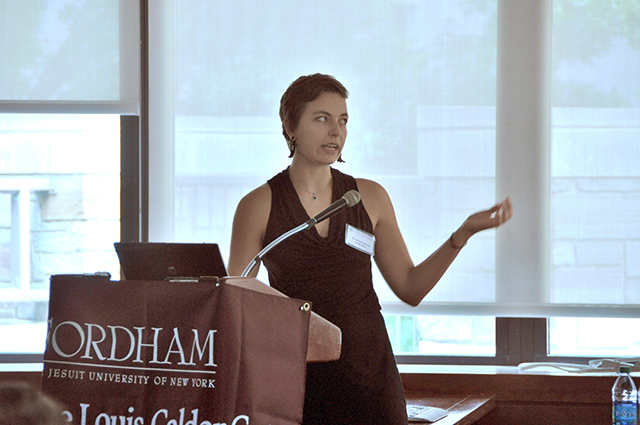
“Once you learn the terminology, it doesn’t seem strange,” said Bishop, a Botany major who plans to graduate following the 2015 fall semester. “Those terms represent ways specific plants mate. When I was presenting, I just called them CH and CL and the biologists knew what I’m referring to.”
Bishop’s presentation on seed variations concluded three months of participation in Fordham University’s Calder Summer Undergraduate Research program. She was one of only two students selected from universities other than the host school, and among a group of seven selected for the grant-funded study.
While the honor of being chosen for the prestigious program was rewarding, the fieldwork was humbling. The first two months were spent slogging through tick-infested grass in sweltering 100-degree weather, collecting seeds up and down the eastern seaboard.
“They showed us a map illustrating the concentration of ticks, and right where we were working was the largest cluster,” Bishop said. “Ticks are about the only living organism I can’t deal with.”
Fortunately for the junior from San Rafael, California, the focus of her research was on plants, not arachnids Covering territory from New York state to Virginia, she and other participants harvested seeds to populate a seed bank in Colorado, as part of "Project Baseline," a study designed to collect seeds in order to observe how plants respond, evolutionarily, to climate change.
Bishop’s specific plant, the Clasping Venus Looking Glass, is a flowering herb with five symmetrical purple petals. Her study’s focus was to see if there are any variations at all between the two types of flowers (CH & CL) within populations of the plant (Triodanis perfoliata) along the eastern seaboard.
“The study asked whether or not there were any variations amongst populations,” Bishop said. “The answer was yes. The next step is to find out whether it’s because of environmental or genetic factors.”
Bishop’s entrance into the scientific world followed a 180-degree path that began when she enrolled at Sacramento State with an intent to earn a degree in music. After taking a botany class to fulfill a general education requirement, she became interested in ecology, an abrupt switch from the arts to science.
“I was interested in mycology, but had avoided botany. I didn’t know anything about it,” she said. “After my first botany class, I pursued that as far as I could, leading to my decision to transfer to Humboldt State.”
At HSU, Bishop’s new interest developed further when she began working in Professor Mihai Tomescu’s undergraduate research lab. Her inexperience in science, but eagerness to learn, made her the ideal student for Tomescu’s approach.
“I prefer to take in undergraduates early on, because I believe that doing something is a very good way of learning it,” Tomescu said. “Being able to list a significant undergraduate research experience on your resume´ gives you a tremendous edge and will definitely open pretty much any door you'll knock on upon finishing college.”
Being a “blank slate,” as Bishop calls it, also worked to her advantage in securing the Fordham opportunity.
“I sent in my resume´and got an interview mostly based on my past hiking, outdoor background,” Bishop said. “They wanted undergraduates who didn’t have a lot of experience, but had specific interests. It turned out mine matched exactly what they were looking for.”
During the final month of the summer, Bishop worked on her presentation. The 15-minute summary of her work was warmly received by both current and future biologists on the panel.
Back on campus, Bishop is delving deeper into her botany studies this semester, but hasn’t surrendered her artistic pursuits.
“If I hadn’t gone to New York for the research program, I would have been helping illustrate a flower biology professor Michael Mesler has been working with,” she said. “I’ll always have my right brain interests.”